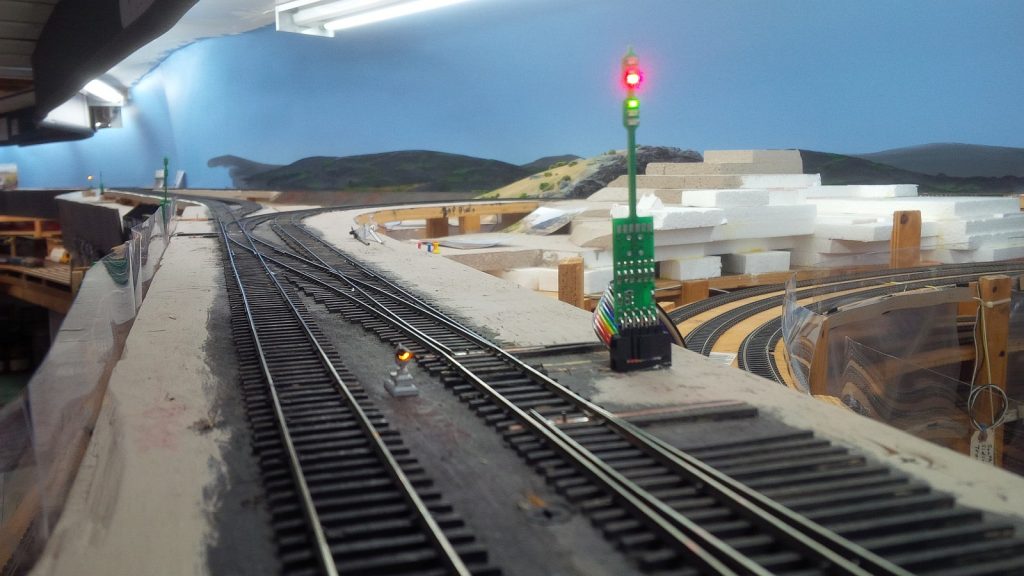Since our club’s initial decision to model the CP Sudbury Division in the 1970s era, it was understood by the membership that at some point railway signals would need to be installed on the layout. Not only did we want our layout scenes to look close to their real place counterparts despite having to selectively compress them, or operate equipment that appeared just like what really ran through northern Ontario in the ’70s, but we also wished to operate the layout in a realistic manner too.
The CP Cartier Subdivision between North Bay and Cartier was all CTC (Centralized Traffic Control) territory during the 1970s, with the exception of the six mile double-track section between Romford and Sudbury yard which was ABS (Automatic Block Signal System) signalled in one direction for current of traffic. Regardless of the two signalling methods it meant the club’s entire east-west mainline was protected by signals, and therefore we would need to duplicate this if we wished to achieve our goals of both looking right, and running right.
That said, we can report that signalling a model railway is very much more easier said than done. However after 20 years of planning, and of delaying a lot of scenery work from being started due to the wiring and complexity of the project, the 1/87 scale Sudbury Division is seeing its first signals begin to sprout around the layout.

Temporary dual-head and permanent dwarf signals installed at Romford. Once fully programmed they will protect this busy junction just like their real-life counterparts.
Though much of the hobby has progressed quite dramatically over the past 40 years, sadly the process of signalling a layout has lagged behind despite the pioneering efforts of Allen MccLelland’s V&O, or Bruce Chubb’s Sunset Valley back in the 1970s. Yes, there are multiple sources of hardware available, and JMRI (Java Model Railroad Interface) software is free, however none of this is really plug and play. You need to program signal scripts and modify JMRI for any of this to work. Between knowing where the signals need to be installed, planning and wiring the signal blocks accordingly, selecting the detectors, switch and signal controllers and then programming it all to work, there is one other big problem for us. No one out there offers ready-to-run Canadian-style searchlight signals.

From the cab of ‘The Canadian’ at Romford, ON – 06 October 1971. Photo by Roger Puta, from Marty Bernard’s Flickr album.
Though searchlight signal kits do exist in HO scale, they are US-based and need to be disassembled and pretty much scratch-build to have them appear like the real deal did. This and both CP and CN did have some differences in their ladder assemblies. For this reason, the WRMRC has decided to build their own, and to use temporary signals in the meantime. But it sure would be nice if a Canadian model manufacturer considered reproducing them for HO modellers at some point. Hello Rapido; wink, wink, nudge, nudge!

Westbound signals guarding Romford. The mainline is on the right. The wye tracks to the left connect with the Parry Sound Sub to Toronto. The track in the middle is a set-off siding.
There is also the little wrinkle of the dispatcher needing a CTC panel for this all to work. However the good news for the WRMRC is the CP Cartier Sub was signalled in the 1960s, and thus never used one of the ‘classic’ CTC panels that railfans usually imagine. CP had their own hybrid system housed on the second floor of the Sudbury Division HQ building, featuring a large white wall panel with a black trackage schematic, and yellow lights displaying track occupancy. The dispatcher set switches and direction of traffic with a keypad assembly. Frankly, this sounds a lot like something you can duplicate on a computer screen and controlled with a keyboard, and so that’s exactly what we will be doing.

Temporary dual-head signals protect the CP Cartier Sub diamond crossing with the CN Bala Sub at Coniston, Ontario. The diamond, much like our signals, is a work in progress.
Regardless of all these difficulties, the WRMRC has a small team working on the project and they’ve been making great strides recently. As you can tell from the photographs, the layout is already looking dramatically different. We look forward to the day we can ‘un-bag’ these signals for a future operating session, and have our engineers operate their trains as per signal indication. This also means scenery can progress in these areas too. The WRMRC’s goals of ‘looking right’ and ‘running right’ are slowly being achieved.
